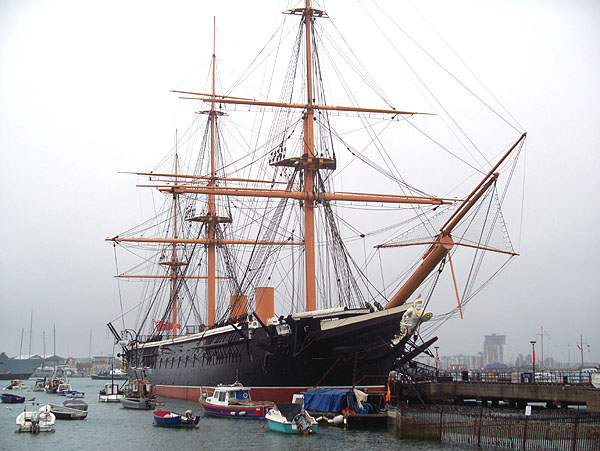
The Historic Dockyard is on the waterfront and next to the working Royal Navy dockyard. The ticketing reflects the presence there of several major attractions, and you can elect to buy a ticket for one, or the whole lot. The all-attractions tickets are much better value for money, but this assumes you are staying in the area and can visit on two or three days.
The major attractions are:
HMS Warrior: One of the very few surviving ‘transition’ warships, with an iron hull, armour plate, and a steam engine, but also rows of cast-iron cannon* poking out of gunports, and masts and sails. She made all previous battleships obsolete, but was soon superseded. Visit time ~1.5 hours.
HMS Victory: Admiral Nelson, Battle of Trafalgar: need I say more? Classic wooden battleship with 3 decks of cannon. Visit time ~1.25 hours.
Mary Rose: Now in a new-for-2013 museum which displays some of the 19,000 artefacts alongside the half-ship. The museum is on three levels. Artefacts such as cannon are displayed in their proper positions opposite the Mary Rose’s decks and there are museum galleries with more artefacts and exposition at the ends. Includes cases of the only Tudor longbows you’ll see anywhere. Fascinating. New for July 2016: the bulky pipework and the barrier with small windows have been removed, offering an unobstructed view of the ship. On the topmost level, above the glass barrier there is nothing between you and the ship. Every few minutes the lights dim, and dioramas of the crew at work or in action are projected onto the hull. Visit time ~3 hours.
Harbour Cruise: A cruise around the harbour, taking you past whichever of the Royal Navy’s ships are in port at the time. I saw a (or is that ‘the’) carrier, and three Daring-class destroyers, plus sundry other warships. Time: ~45 mins.
Royal Naval Museum: Seems to be confined to the age of sail, and Trafalgar.
Other attractions: There are several other things (see the official website.)
Monitor M33: In a drydock near the Victory. You can now see around the restored interior of this ship. See separate entry for M33.
Travel: It’s easy to get right into Portsmouth by car along the motorway. You could park at the convenient but expensive pay-on-exit multi-storey car park near the Historic Dockyard, but it is less stressful and just as convenient to use the Portsmouth Park & Ride.
The Portsmouth railway station is actually on the harbour nearby.
Jutland 2016 Exhibition (temporary): An optional extra in the ticketing scheme. Worth a look if you know little about this important battle. A fair number of small artifacts are on display, and there are some video clips and survivor accounts.
*mostly fibreglass replicas.
